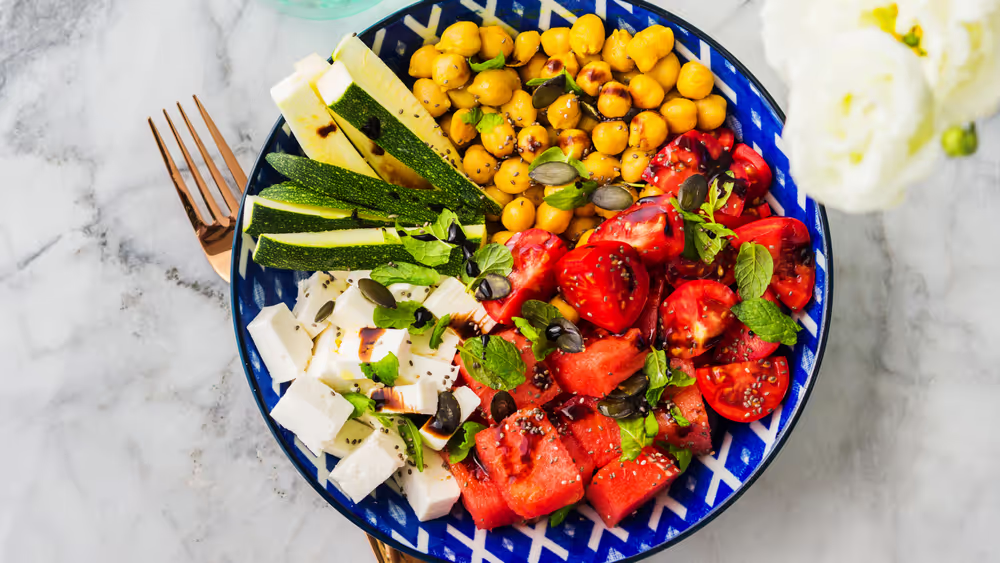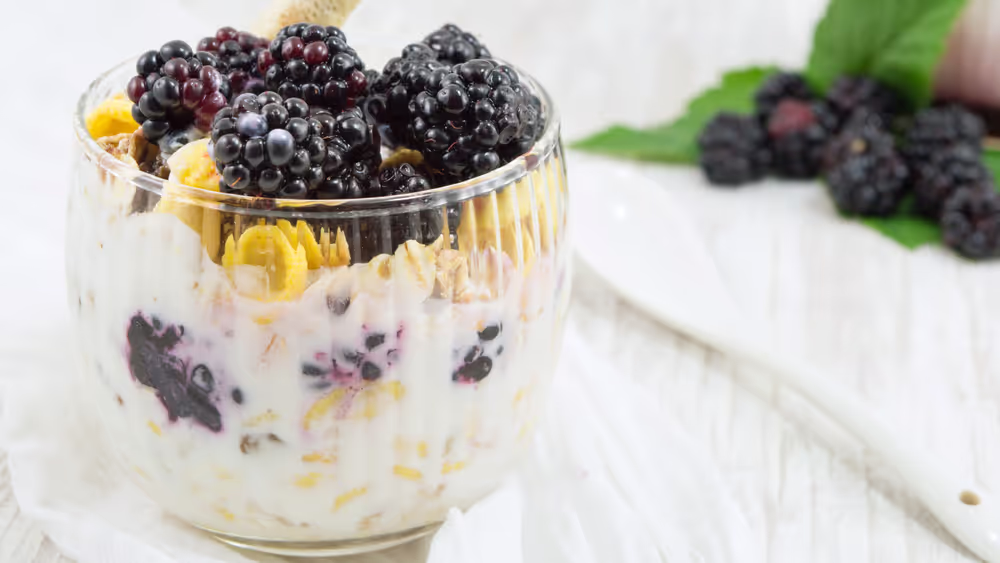If you have irritable bowel syndrome (IBS), you've likely heard of the low FODMAP diet. FODMAPs are fermentable, short-chain carbohydrates in various foods that can trigger IBS symptoms like gas, bloating, and abdominal pain because they're poorly absorbed in the small intestine.
However, the low-FODMAP diet isn't about cutting all high-FODMAP foods out forever—it's a strategic, science-backed approach to identifying which specific FODMAPs might be causing your symptoms.
Read on to learn what a low-FODMAP diet is, which foods trigger IBS symptoms, tips for getting started on the low-FODMAP diet, and most importantly, advice on how to be less restricted on the low-FODMAP diet so you're not stuck eating only low-FODMAP foods.
What is a low FODMAP diet?
What is a FODMAP? FODMAPs are fermentable, short-chain carbohydrates (sugars) that are poorly absorbed in the small intestine and enter the large intestine intact. Here, they are fermented by the gut bacteria and draw water into the large intestine. While this prebiotic effect can benefit many people's gut health, these foods can trigger unpleasant digestive symptoms for some individuals.
A low-FODMAP diet temporarily reduces consumption of high-FODMAP foods to determine which, if any, FODMAPs are causing the gastrointestinal symptoms.
What does FODMAP stand for?
FODMAP stands for Fermentable Oligosaccharides, Disaccharides, Monosaccharides, and Polyols. Here's a list of the individual FODMAPs from each category:
- Oligosaccharides: Fructans and galacto-oligosaccharides (GOS)
- Disaccharides: Lactose
- Monosaccharides: Excess fructose
- Polyols: Artificial sweeteners called sugar alcohols (sorbitol and mannitol are the main ones, but this group also contains maltitol, xylitol, lactitol, and isomalt).
Fructans
Here's a list of foods high in fructans:
- Artichoke
- Asparagus
- Banana (ripe)
- Barley
- Black beans
- Brussels sprouts
- Cabbage (such as Savoy cabbage)
- Cashews
- Chicory root
- Garlic
- Inulin
- Leeks (the white part)
- Lima beans
- Navy beans
- Onions
- Persimmon
- Pistachios
- Red kidney beans
- Rye
- Scallions (the white part)
- Shallots
- Spelt
- Watermelon
- Wheat (bread, pasta, breakfast cereals, etc.)
If you have a fructan intolerance, consider swapping foods like onion and garlic for garlic-infused olive oil or the green tops of scallions. Replace wheat, barley, and rye with gluten-free or low-FODMAP grains like rice, quinoa, or oats. If you'd like to avoid restricting these foods, try a digestive enzyme supplement like FODZYME, which breaks fructans down so they're better tolerated.

Excess Fructose
Here's a list of foods containing excess fructose:
- Agave syrup
- Apple
- Apricot
- Artichoke hearts (canned)
- Asparagus
- Bell pepper (red, orange, yellow)
- Broccoli (stalks only)
- Broccolini (heads only)
- Butternut squash
- Cherries
- Chicory root powder
- Cucamelon
- Dried fruit
- Fava beans
- Figs
- Fruit juice (such as apple juice and orange juice)
- Garlic (black)
- Garlic shoots
- Grapes (green, white, red)
- Guava
- High-fructose corn syrup
- Honey
- Jackfruit
- Jerusalem artichoke
- Mango
- Molasses
- Nectarine (white)
- Pear
- Sugar snap peas
- Tomato (Roma, cherry)
- Tomato juice
- Watermelon
If your body struggles to digest foods with excess fructose, try substituting low-FODMAP fruits, such as unripe bananas, blueberries, and strawberries, and low-FODMAP vegetables, such as spinach, zucchini, and carrots.
Some foods with excess fructose can be tolerated in smaller portions, such as grapes or tomatoes. When choosing sweeteners to use in your low-FODMAP recipes, opt for low-FODMAP options like white sugar, maple syrup, rice malt syrup, stevia, or monk fruit instead of high fructose corn syrup or honey.
Galacto-oligosaccharides
Here's a list of foods high in galacto-oligosaccharides (GOS):
- Almonds
- Beets
- Bitter melon
- Black beans
- Cashews
- Chickpeas (in serving sizes of more than ¼ cup)
- Green peas
- Kidney beans
- Lentils (in serving sizes of more than ¼ cup)
- Navy beans
- Oat milk
- Pine nuts
- Pistachios
- Pinto beans
- Soft tofu
- Soybeans or edamame
- Other soy-based products like soymilk made from whole soybeans
- Split peas
- Taro
- Turnip
- Tuscan kale
If foods with GOS trigger your symptoms, try using canned legumes (like lentils and chickpeas). They're lower in GOS because much of the oligosaccharides leach out during canning. Drain and rinse thoroughly to remove the GOS.
If you eat tofu, choose firm tofu, which is lower in GOS. Finally, many foods with GOS can be tolerated in small amounts. If you want to eat larger portions, consider a digestive enzyme supplement like FODZYME, which breaks down the GOS, making them easier to tolerate.
Lactose
Here's a list of foods that are high in lactose:
- American cheese
- Buttermilk
- Condensed milk
- Cream
- Custard
- Evaporated milk
- Fresh cheeses (like ricotta, cream cheese, and cottage cheese)
- Halloumi
- Ice cream
- Kefir
- Milk (goat, cow, sheep)
- Paneer
- Queso fresco
- Quark
- Sour cream
- Yogurt
Lactose is found in many (but not all) dairy foods. If you're lactose intolerant, choose lactose-free milk, yogurt, and cheese. When choosing lactose-free yogurt, ensure it doesn't contain any high-FODMAP ingredients like honey. Alternatively, choose naturally low-lactose cheeses like aged or hard cheeses or dairy alternatives like almond milk and soy milk.
Most people with lactose intolerance can tolerate small portions of lactose, so experiment with small amounts to see how your body reacts. For added flexibility, consider using digestive enzymes like FODZYME, which breaks down the lactose in your meals.

Polyols
Here's a list of foods high in polyols (sugar alcohols):
- Apples
- Apricots
- Blackberries
- Cauliflower (white)
- Celery
- Cherries
- "Diet" or "sugar-free" baked goods
- Low-calorie sweeteners (sorbitol, mannitol, xylitol, lactitol, maltitol, and isomalt)
- Mushrooms (black chanterelle, button, dried porcini, enoki, portobello, shiitake)
- Nectarines
- Peaches
- Pears
- Plums
- Prunes
- Rutabaga
- Sauerkraut (white cabbage)
- Sugar-free candies, chocolate, and gum
- Wakame seaweed (dried flakes)
- Watermelon
If foods with polyols trigger symptoms, try gradually reintroducing them to your diet by eating a small amount of foods with polyols alongside a balanced, low-FODMAP meal. This may help reduce symptoms by lessening their osmotic effect (i.e., their tendency to draw water into the bowels). However, this varies from person to person, and a food and symptom journal can guide you in determining what works best for your body.
FODMAPs and IBS
Remember how FODMAPs get fermented by the gut bacteria? Gas is produced as a byproduct of the fermentation process. In addition, water is pulled into the large intestine. For most people, the stretching of the gut walls that accompanies excess gas production and the osmotic effect of FODMAPs doesn't cause too many issues. But for people with extra sensitive digestive systems (known as visceral hypersensitivity), the stretching of the gut walls can be extremely painful. It's thought that visceral hypersensitivity is one reason FODMAPs can trigger symptoms in people with IBS.
Here are some typical symptoms of a FODMAP intolerance:
- Gas
- Bloating
- Flatulence
- Abdominal pain
- Constipation
- Diarrhea
Tracking your food and looking at patterns between certain foods and your symptoms can be helpful in determining whether you have a FODMAP intolerance. Start by noting the time of day, what you've eaten (including portion sizes) and any symptoms that arise. This can allow you to see relationships between what you've eaten and your digestive symptoms.
Another way of determining whether you have a FODMAP intolerance is following a low-FODMAP diet. You'll temporarily reduce your intake of FODMAPs, then systematically reintroduce them to see which ones cause symptoms. It's best to do this with a registered dietitian. The low-FODMAP diet is very restrictive, and a dietitian can help ensure you get the proper nutrients while limiting FODMAPs.
FODMAP diet vs other diets
While there are many overlaps between the low-FODMAP diet and other popular diets, some key differences exist.
- Dairy-free: Many dairy products contain lactose. However, while the low-FODMAP diet eliminates certain dairy products, such as milk and yogurt, other dairy products, such as aged cheese, are low in lactose and, therefore, okay to eat on the low-FODMAP diet. In contrast, a dairy-free diet eliminates all dairy products, regardless of their lactose levels.
- Gluten-free: Many foods containing gluten also contain FODMAPs (specifically, fructans). However, gluten is a protein, while fructans are carbohydrates. Gluten can cause an autoimmune reaction in people with celiac disease, while foods with fructans do not cause an autoimmune reaction. In addition, while some low-FODMAP foods are gluten-free, not all are. Wheat contains both gluten and fructans.
- Vegan: A vegan diet eliminates all animal products. Since many animal products do not naturally contain FODMAPs, a low-FODMAP diet can include animal products like meat, fish, poultry, eggs, and low-lactose dairy products.
How to tell if you need a low FODMAP diet?
Research shows that a low-FODMAP diet can help relieve gastrointestinal symptoms and improve quality of life in adults with IBS. But how do you know if it's right for you?
Always consult with an expert
Since the low-FODMAP diet is very restrictive, it's important to consult with a healthcare provider like a medical doctor or registered dietitian before starting one. If you do plan on following a low-FODMAP diet or a FODMAP gentle diet, working with a dietitian can help ensure you get the nutrients you need.
Elimination diets
The low-FODMAP diet is an elimination diet. It involves three distinct phases where you'll be eliminating and reintroducing FODMAPs: elimination, reintroduction, and personalization.
The low-FODMAP diet's elimination phase typically lasts 2 to 6 weeks. During this time, you'll stop eating high-FODMAP foods like wheat, many dairy products, certain fruits and vegetables (like stone fruits, onion, and garlic), and many legumes and instead eat lower-FODMAP alternatives. You'll likely also need to swap in some low FODMAP-friendly sweeteners, as many sugars and sugar alcohols can be high FODMAP. Reference guides on what to buy on a low FODMAP diet to make shopping easier.
This trial period gives you a chance to see your digestive symptoms improve and determine whether FODMAPs as a whole are responsible for your symptoms.
If you still have digestive problems after 2 to 3 weeks of following a low-FODMAP diet, it's possible that FODMAPs aren't responsible. About a quarter of people with IBS don't find relief on a low-FODMAP diet and instead need to consider other IBS therapies, like gut-directed hypnotherapy, stress management, fiber supplements, and more.
After the elimination phase comes the reintroduction phase (also known as the challenge phase). This phase is essential, as it enables you to determine which specific FODMAPs you're sensitive to. During this phase, you'll reintroduce FODMAPs one group at a time while keeping the rest of your diet low-FODMAP.
Here's an example of a reintroduction for fructans:
- Day 1: ¼ garlic clove
- Day 2: ½ garlic clove
- Day 3: 1 garlic clove
If you experience symptoms after reintroducing a certain FODMAP, go back to eating low-FODMAP for a few days to get your symptoms under control. Then, try the reintroduction one more time. This is important, as other factors like poor sleep and stress can also cause IBS symptoms. Trying a reintroduction twice helps determine whether it was truly the FODMAPs or something else causing your symptoms.
Once you've gone through the entire reintroduction phase (which should take about 8 to 12 weeks, as it's best to leave 2 to 3 days between reintroductions), you'll move on to personalization. Personalization is important for ensuring you get all the nutrients you need from your diet.

Personalization
During the personalization or integration phase, you'll create an eating plan that includes the FODMAPs you tolerated during the reintroduction phase and limits the ones that trigger symptoms. This lets you create a sustainable, long-term diet that caters to your specific intolerances while maximizing dietary variety and nutritional balance.
It may surprise you to learn that most people aren't sensitive to all FODMAP groups. Instead, many people find that one or two groups trigger symptoms, while they can eat the other FODMAP groups without any symptoms. For example, you may struggle with lactose and fructans but can tolerate excess fructose and polyols. It's all about finding the best combination of foods for you.
How to be less restricted
The low-FODMAP diet doesn't have to mean permanent restriction and there are ways to make a low FODMAP diet more manageable. Your tolerance to foods high in FODMAPs may change over time due to factors like stress, exercise habits, changes in your gut bacteria, and overall well-being. It's important for people with IBS to re-challenge the foods that caused symptoms every 3 to 6 months to see whether previously problematic foods are now better tolerated.
To expand your diet with confidence, consider tools like FODZYME. This digestive enzyme supplement, sprinkled directly onto your foods, helps break down FODMAPs like fructans, GOS, and lactose, allowing you to enjoy foods like pasta, pizza, garlic, onions, legumes, and dairy products with fewer issues.
Remember, the low-FODMAP diet is about finding what works best for you. Whether that's by reducing your intake of certain high-FODMAP foods or using digestive enzymes to break down the FODMAPs that trigger your symptoms, each person will have their own unique IBS management plan.


 Sarah Glinski, RD
Sarah Glinski, RD